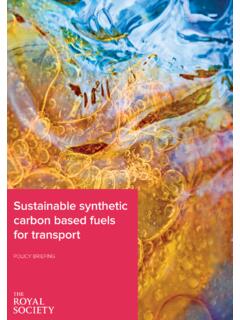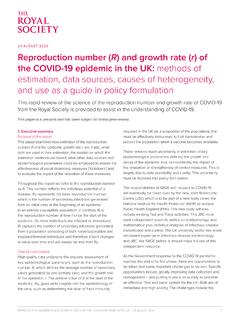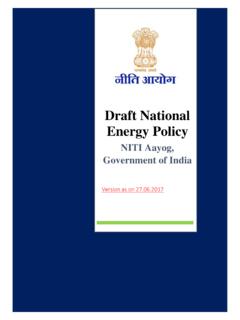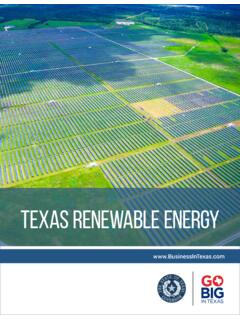Transcription of Climate change: A Summary of the Science - Royal Society
1 Climate change: a Summary of the scienceSeptember 2010 GlossaryWm-2 (watts per metre squared)The amount of energy that falls on a square metre in one second. Sometimes known as a cycleThe term used to describe the flow of carbon, in its various forms, between the atmosphere, oceans, plants, soils and rocks.
2 In the atmosphere, carbon mostly exists as carbon dioxide, but it exists in different forms in other components, such as organic carbon in the forcing (also known as radiative forcing)The imbalance in the Earth s energy budget resulting from, for example, changes in the energy received from the Sun, changes in the amounts or characteristics of greenhouse gases and particles, or changes in the nature of the Earth s surface. Hence Climate forcing can result from both human activity and natural causes. It is given in units of Wm-2. Climate sensitivityThis is the amount of Climate change (as measured by the change in globally-averaged surface temperature) for a given amount of Climate forcing.
3 It is often quoted (as will be the case here) as the temperature change that eventually results from a doubling in CO2 concentrations, which is calculated to cause a Climate forcing of about Climate variability: Climate change that occurs in the absence of natural or human-induced Climate forcing as a result of interactions within and between the various components of the Climate system (such as the atmosphere, the oceans and the frozen world).Introduction1 Changes in Climate have significant implications for present lives, for future generations and for ecosystems on which humanity depends. Consequently, Climate change has been and continues to be the subject of intensive scientific research and public debate.
4 2 There is strong evidence that the warming of the Earth over the last half-century has been caused largely by human activity, such as the burning of fossil fuels and changes in land use, including agriculture and deforestation. The size of future temperature increases and other aspects of Climate change, especially at the regional scale, are still subject to uncertainty. Nevertheless, the risks associated with some of these changes are substantial. It is important that decision makers have access to Climate Science of the highest quality, and can take account of its findings in formulating appropriate responses. 3 In view of the ongoing public and political debates about Climate change, the aim of this document is to summarise the current scientific evidence on Climate change and its drivers.
5 It lays out clearly where the Science is well established, where there is wide consensus but continuing debate, and where there remains substantial uncertainty. The impacts of Climate change, as distinct from the causes, are not considered here. This document draws upon recent evidence and builds on the Fourth Assessment Report of Working Group I of the Intergovernmental Panel on Climate Change (IPCC), published in 2007, which is the most comprehensive source of Climate Science and its uncertainties. Climate change: a Summary of the Science I September 2010 I 1 The Royal SocietyThe greenhouse effect4 The Sun is the primary source of energy for the Earth s Climate .
6 Satellite observations show that about 30% of the Sun s energy that reaches the Earth is reflected back to space by clouds, gases and small particles in the atmosphere, and by the Earth s surface. The remainder, about 240 Watts per square metre (Wm-2) when averaged over the planet, is absorbed by the atmosphere and the To balance the absorption of 240 Wm-2 from the Sun, the Earth s surface and atmosphere must emit the same amount of energy into space; they do so as infrared radiation. On average the surface emits significantly more than 240 Wm-2, but the net effect of absorption and emission of infrared radiation by atmospheric gases and clouds is to reduce the amount reaching space until it approximately balances the incoming energy from the Sun.
7 The surface is thus kept warmer than it otherwise would be because, in addition to the energy it receives from the Sun, it also receives infrared energy emitted by the atmosphere. The warming that results from this infrared energy is known as the greenhouse Measurements from the surface, research aircraft and satellites, together with laboratory observations and calculations, show that, in addition to clouds, the two gases making the largest contribution to the greenhouse effect are water vapour followed by carbon dioxide (CO2). There are smaller contributions from many other gases including ozone, methane, nitrous oxide and human-made gases such as CFCs (chlorofluorocarbons).
8 Climate change7 Climate change on a global scale, whether natural or due to human activity, can be initiated by processes that modify either the amount of energy absorbed from the Sun, or the amount of infrared energy emitted to Climate change can therefore be initiated by changes in the energy received from the Sun, changes in the amounts or characteristics of greenhouse gases, particles and clouds, or changes in the reflectivity of the Earth s surface. The imbalance between the absorbed and emitted radiation that results from these changes will be referred to here as Climate forcing (sometimes known as radiative forcing ) and given in units of Wm-2. A positive Climate forcing will tend to cause a warming, and a negative forcing a cooling.
9 Climate changes act to restore the balance between the energy absorbed from the Sun and the infrared energy emitted into space. 9 In principle, changes in Climate on a wide range of timescales can also arise from variations within the Climate system due to, for example, interactions between the oceans and the atmosphere; in this document, this is referred to as internal Climate Climate and Climate change: some background scienceClimate change: a Summary of the Science I September 2010 I 2 The Royal Societyvariability . Such internal variability can occur because the Climate is an example of a chaotic system: one that can exhibit complex unpredictable internal variations even in the absence of the Climate forcings discussed in the previous paragraph.
10 10 There is very strong evidence to indicate that Climate change has occurred on a wide range of different timescales from decades to many millions of years; human activity is a relatively recent addition to the list of potential causes of Climate change. 11 The shifts between glacial and interglacial periods over the past few million years are thought to have been a response to changes in the characteristics of the Earth s orbit around the Sun. While these led to only small changes in the total energy received from the Sun, they led to significant changes in its geographical and seasonal distribution. The large changes in Climate , in moving in and out of glacial periods, provide evidence of the sensitivity of Climate to changes in the Earth s energy balance, whether attributable to natural causes or to human activity.












